Franco's Female Prisoners
|
Franco's
Female Prisoners
Thesaurus room, La Nau
5th June – 5th October
From
Tuesday to Saturday, from 10 to 13.30 and from 16 to 20 h.
Sunday, from 10 to 14 h.
|
|
|
|
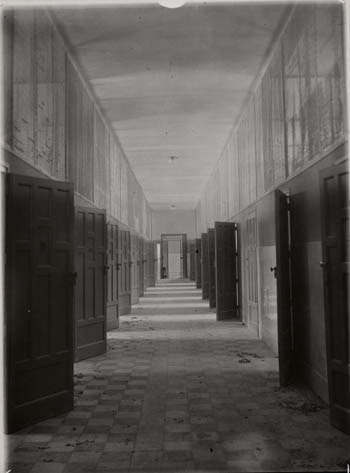
Ministerio de Cultura. AGA. Sección Cultura. IDD:
(03)084.001. Signaga 33/F/00750. Vista interior de una
galería de la cárcel de Ventas, 1933. |
|
|
|
Curators: Sergio Gálvez and Fernando Hernández
Organised by: Fundación de Investigaciones Marxistas
and Universitat de València
Women like Tomasa Cuevas, Manolita del Arco, Juana Doña,
Nieves Torres, María Salvo, Trinidad Gallego, Soledad
Real, Leonor Estévez, Mari Carmen Cuesta, Carlota
O’Neill, Concha Carretero, Maruja Borrell, Matilde Landa,
Ángeles García-Madrid, Josefina Amalia Villa and many
other are members of a generation –that of the 2nd
Republic and the Civil War- whose remembrance and
history are slowly being acknowledged. This first
generation of female political prisoners of Franco's
regime is well rooted into the "democratic substrate" of
20th century fights, demands and disputes in
Spain which queried the domineering society model of the
time with greater impact than what we commonly assume.
Today we talk about the “historical failure of Franco's
period", not because of the "democratic conversions" of
a number of his follower “intellectuals” or the internal
evolution of power clans during the dictatorship or
international democratising waves, as argued by some
elite views of the past and society. The real
characters that help explain the failure are much lesser
known; no streets, squares or parks are named after
them. We refer to grass-root movements against Franco
chased by the dictator and, more particularly, to female
political prisoners from the regime’s first two decades.
Politically active via Republic reforms, these young
women were punished with long-term imprisonment and even
the death penalty not only for their courage to stand up
against Fascism but also for their belonging to a
patriarchal society with secular roots. |
|
|
|
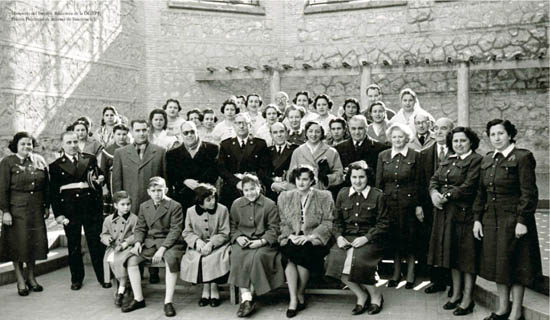
Ministerio del Interior. Biblioteca de la DGIIPP.
Prisión Provincial de mujeres de Valencia, s/f. |
|
|
|
In spite of this starting point, the dual repression
suffered by this generation must be borne in mind: they
were both rojas (red: communist) and women.
All this in a context marked by a totalitarian
dictatorship with clear Fascist elements in the first
years, one that followed archaic patriarchal and
misogynous traces, one that imposed the wife-mother
woman model confined to the household, marginalised from
the public realm and subjected to male authority.
In this environment, the struggle, commitment and in
many cases sheer survival of "Franco's female political
prisoners" both inside and outside the “penitentiary”
refer us to stories of pain, sadness and fear rather
than to a heroic, often glorified past. |
|
|
|
We should not forget, anyway, that this relevant fact
–the imprisonment of the ‘rojas’, of that first
generation of women found guilty for “war and post-war
crimes” taken to prison for being relative to male
militants or union leaders, or for being feminist or
members of a party- has been concealed for too long or
subsumed into their peer male generation, on which we
have at least some general knowledge. Thus, if the
testimony of these militants is now essential in
determining the qualitative and quantitative dimensions
of Franco's repression, we must remember how they were
hidden and silenced for years or overlooked by the
academics or the institutions. Premises, party orders,
specific political situations and, why not, the
reminiscence of too strong a past were some of the
elements behind the construction of the so-called “pact
of silence”. Among the causes of that highly frequent
omission in the construction of the history of this
militant experience is also the patriarchal bias of the
socioeconomic and cultural system of relations, which,
as far as its cross-cutting nature is concerned, does
not know of classes or ideologies. |
|
|
|
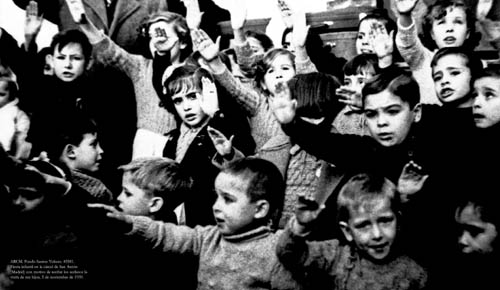
ARCM. Fondo Santos Yubero. 45581. Fiesta infantil en la
cárcel de San Antón (Madrid) con motivo de recibir los
reclusos la visita de sus hijos, 5 de noviembre de 1939. |
|
|
|
Basically, we are dealing with historical realities of
female repression under Franco’s regime -the experience
of prisoner mothers raising their children in prison,
women working in jail to support their families, the
special “prostitutes’ prisons”, and women working to
support their imprisoned partners- which have
traditionally been either removed from or not duly
acknowledged by not only the institutional discourse but
also the antagonist one. Our collective memory does know
something about resistance against Franco at the Burgos
male prison but very little is known about their female
counterparts, namely the central prisons of Segovia,
Ventas or Palma.
As a consequence, invisibility has remained, as proved
by the absence of this historical experience in
institutional recognition processes -unevenly
distributed in Spain- and academic ones, particularly as
a very poorly explored object of study, at least up to
the late1990s. The gaps in historical generational
collective memory range from the absence of recognition
and signage of "memory sites" (walls, prisons) to the
clear lack of interest in unravelling the story of its
male and female players. |
|
|
|
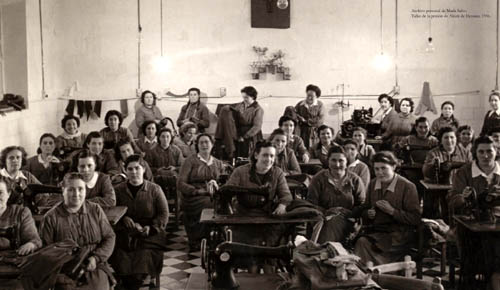
Archivo personal de María Salvo. Taller de la prisión de
Alcalá de Henares, 1956. |
|
|
|
The exhibition Franco’s female prisoners contributes to
visualising women's prison experiences over the first
decades of Franco's dictatorship based on an ongoing
dialogue between memory and history in which images and
documents come together with the memories and
testimonies of the prisoners. Documents and photographs
of different origins, from personal and public files,
live together with the recorded and transcribed memories
of the exhibition’s main characters. At the same time, a
tour around different thematic axes –children and work
in prison, organised resistance- includes the individual
treatment of the most significant prisons -Ventas,
Saturrarán, Palma, Les Corts-, a particular universe
within a broader framework, that of Franco's female
repression.
Our aim is to continue reconstructing a period in
contemporary history marked by the trauma and terror of
the Civil War and, more particularly, by Franco's
dictatorship in which the voice, testimony and memory of
those excluded from the “great stories” are at last
present as main witnesses and players. At the same time,
the exhibition seeks to show audiences a historical
human, social and political experience, one which is as
singular as fundamental to the settlement of the
"democratic substrate" mentioned earlier. Indeed, what
is really at stake is the construction of a
democratic and social memory, which always calls for
new contributions and views. |
|
|
|
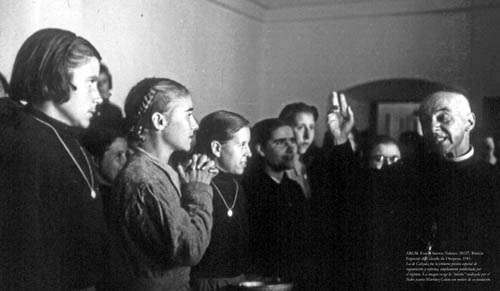
ARCM. Fondo Santos Yubero. 38127. Prisión Especial de
Calzada de Oropesa, 1941. La de Calzada fue la primera
prisión especial de regeneración y reforma, ampliamente
publicitada por el régimen. La imagen recoge la “misión”
realizada por el Padre jesuita Martínez Colom con motivo
de su fundación. |
|
|
|
The exhibits come from the following public and private
archives:
Archivo General de la Administración (AGA), Archivo
General de la Guerra Civil, Arxiu Nacional de Cataluña
(ANC), Archivo Histórico del PCE (AHPCE), Arxiu
Fotogràfic de la Ciutat de Barcelona, Archivo Regional
de la Comunidad de Madrid (ARCM), Arxiu Històric de Les
Corts (AHLC), Archivo Museo Reina Sofía, Archivo
Alfonso, Archivo Agencia EFE, Archivo Militar de
Segovia, Archivo del Centro Penitenciario Victoria Kent
de Madrid, Archivo de la Prisión Provincial de Segovia,
Archivo Asociación de Ex-Presos y Represaliados
Políticos Antifranquistas, Archivo General de la Primera
Región Militar, Arxiu Històric de la C.O.N.C. / Fundació
Cipriano García, Biblioteca de la Dirección Gral. de
Instituciones Penitenciarias, Biblioteca Nacional,
Biblioteca Fundación de Investigaciones Marxistas,
Centro de Documentación Asociación Matilde Landa.
Personal archives: Carmen Rodríguez Sánchez, Matilde
Landa, Blanca Brissac, Carlota O'Neil, Manolita del Arco
and Martina Barroso. |
|
|
|
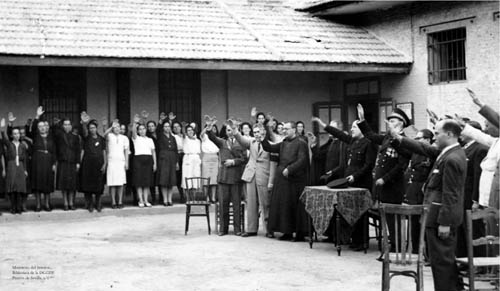
Ministerio del Interior. Biblioteca de la DGIIPP.
Prisión de Sevilla, s/f. |
|
|
|
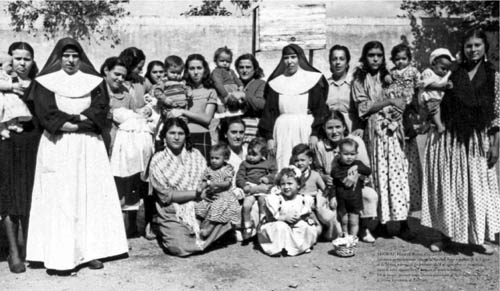
AHCB-AF. Pérez de Rozas. CG/24-09-1952. Solamente en
tres ocasiones especiales, Navidad, Reyes y la fiesta de
la Virgen de la Merced, patrona de las prisiones -el 24
de septiembre- se permitía la visita de niños durante
varias horas en el recinto carcelario. En la imagen
aparecen varias gitanas, disfrutando de la visita de sus
hijos en la prisión barcelonesa de Les Corts. |
|
|
|
|